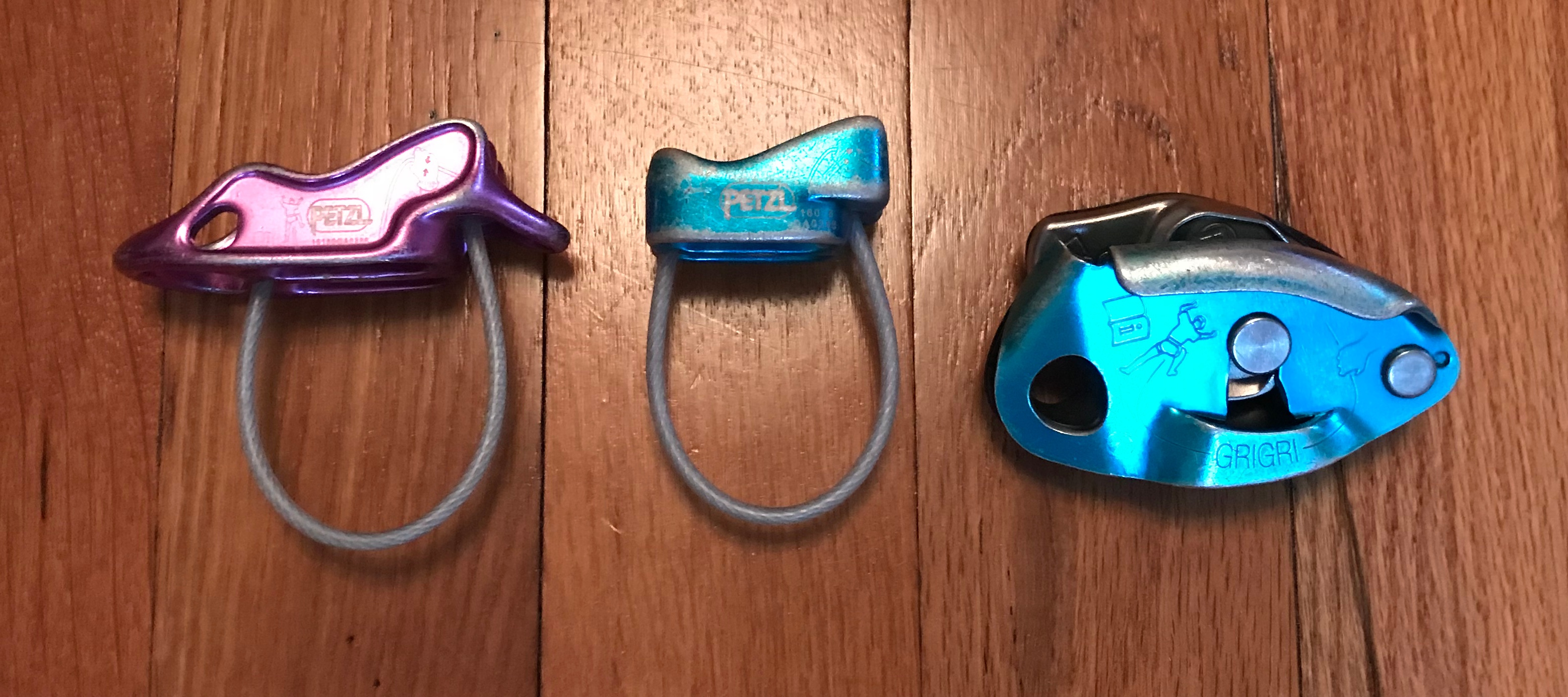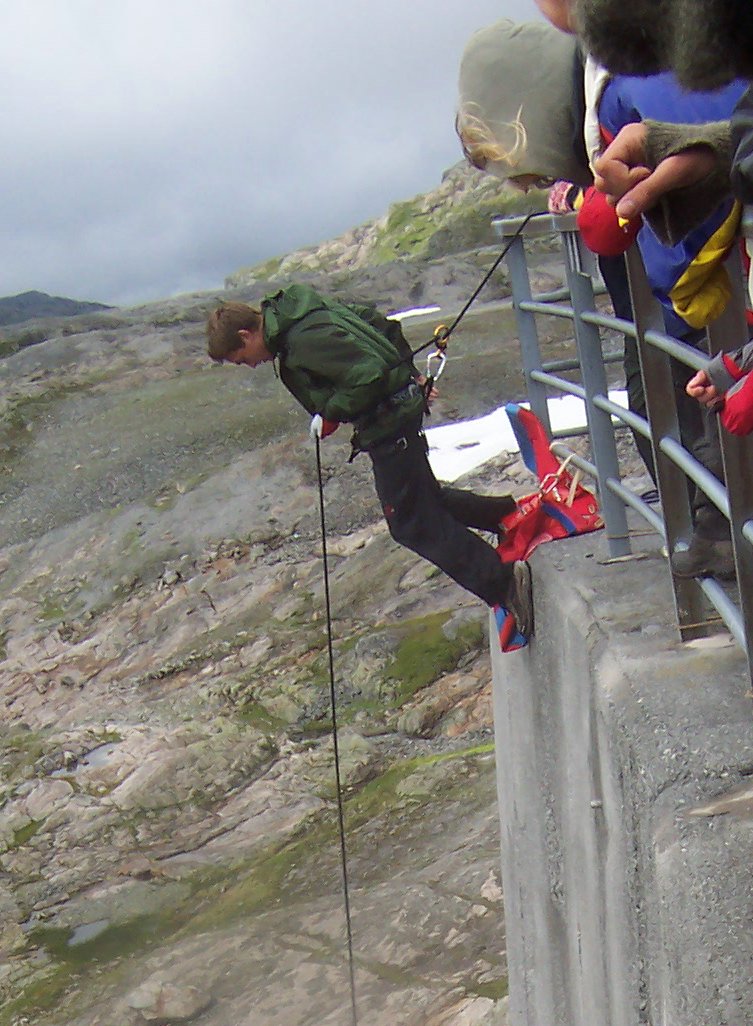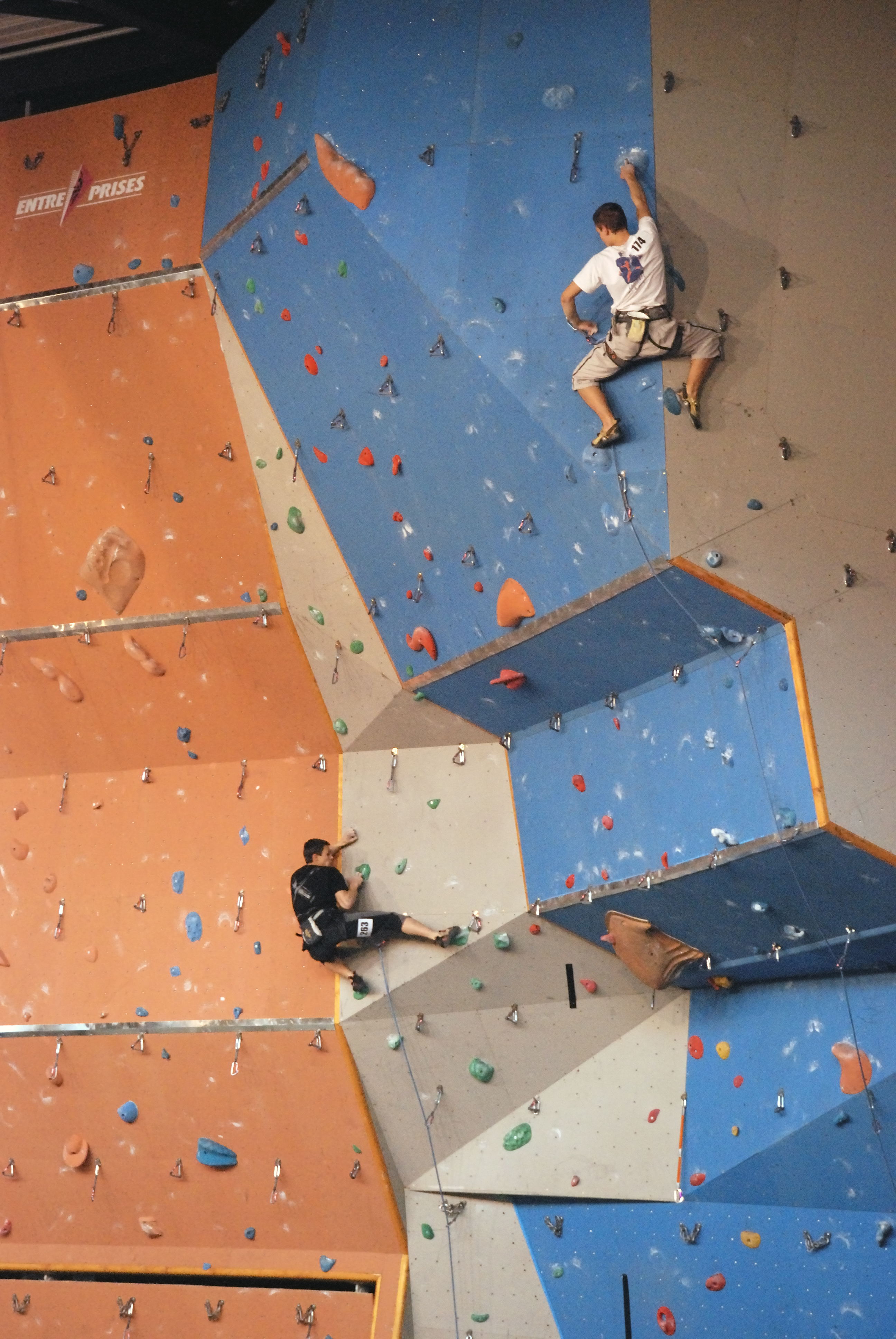|
Reverso (climbing)
A Reverso is a belay device developed and patented by Petzl, used for example in rock-climbing and other activities which involves rope-work. Another version of this device is the Reversino, intended for use with thinner ropes. A Reverso can be used to belay the leader, one or two seconds, or as a descender during rappelling. It can also be used in self-braking mode, to belay one or two seconds, if attached directly to the belay. A Reverso is similar in design and use to an ATC (belay device), ATC when belaying a lead climber from below. A rope passes through the Reverso, through a carabiner attached to both the Reverso and the belayer's harness, and back through the same hole in the Reverso. This creates the friction required to properly belay a climber. When belaying a seconder from the top of a climb, the Reverso is attached by a carabiner through the "extra loop" that an ATC (belay device), ATC does not have, to the anchors in the place of an italian hitch knot. Using thi ... [...More Info...] [...Related Items...] OR: [Wikipedia] [Google] [Baidu] |
Climbing
Climbing is the activity of using one's hands, feet, or other parts of the body to ascend a steep topographical object that can range from the world's tallest mountains (e.g. the eight thousanders) to small boulders. Climbing is done for locomotion, sporting recreation, for competition, and is also done in trades that rely on ascension, such as construction and military operations. Climbing is done indoors and outdoors, on natural surfaces (e.g. rock climbing and ice climbing), and on artificial surfaces (e.g. climbing walls and climbing gyms). The sport of climbing evolved by climbers making first ascents of new types of climbing routes, using new climbing techniques, at ever-increasing grades of difficulty, with ever-improving pieces of climbing equipment. Guides and guidebooks were an important element in developing the popularity of the sport in the natural environment. Early pioneers included Walter Bonatti, Riccardo Cassin, Hermann Buhl, and Gaston Rébuffat, wh ... [...More Info...] [...Related Items...] OR: [Wikipedia] [Google] [Baidu] |
Petzl Reverso 3, Arak
Petzl is a French manufacturer of climbing gear, caving gear, work-at-height equipment, and headlamps based in Crolles (near Grenoble), France. The company was created by the cave explorer Fernand Petzl in the mid-1970s. Their three specialties are: *Vertical sports: equipment for mountaineering, climbing, caving, etc. *Work at height and rescue: solutions for progression and safety in difficult-access worksites and in technical rescue. *Headlamps (head torches) that provide hands-free lighting. History Fernand Petzl, born in 1912, began his caving career in the late 1920s and early 1930s. In 1936, Petzl was introduced to, then small-time caver, Pierre Chevalier. The two began work on improving the technology behind their sport. In 1943, Chevalier designed and tested the first nylon rope to replace caving ladders. This technology provided the foundation for nearly all vertical safety methods to come. Chevalier's innovation led to the first 1,000 meter cave descent when Petzl ... [...More Info...] [...Related Items...] OR: [Wikipedia] [Google] [Baidu] |
Belay Device
A belay device is a mechanical piece of climbing equipment used to control a rope during belaying. It is designed to improve belay safety for the climber by allowing the belayer to manage their duties with minimal physical effort. With the right belay device, a small, weak climber can easily arrest the fall of a much heavier partner. Belay devices act as a friction brake, so that when a climber falls with any slack in the rope, the fall is brought to a stop. Typically, when the rope is held outward, away from the body, it moves relatively freely, so the belayer can take up or pay out slack. When the rope is brought backward, to the side of the body, the rope is forced into tight bends and rubs against the device and/or against itself, allowing the belayer to arrest the descent of a climber in the case of a fall. This rubbing slows the rope, but also generates heat. Some types of belay devices can arrest a fall without the belayer taking any action, while others require the belay ... [...More Info...] [...Related Items...] OR: [Wikipedia] [Google] [Baidu] |
Petzl
Petzl is a French manufacturer of climbing gear, caving gear, work-at-height equipment, and headlamps based in Crolles (near Grenoble), France. The company was created by the cave explorer Fernand Petzl in the mid-1970s. Their three specialties are: *Vertical sports: equipment for mountaineering, climbing, caving, etc. *Work at height and rescue: solutions for progression and safety in difficult-access worksites and in technical rescue. *Headlamps (head torches) that provide hands-free lighting. History Fernand Petzl, born in 1912, began his caving career in the late 1920s and early 1930s. In 1936, Petzl was introduced to, then small-time caver, Pierre Chevalier. The two began work on improving the technology behind their sport. In 1943, Chevalier designed and tested the first nylon rope to replace caving ladders. This technology provided the foundation for nearly all vertical safety methods to come. Chevalier's innovation led to the first 1,000 meter cave descent when P ... [...More Info...] [...Related Items...] OR: [Wikipedia] [Google] [Baidu] |
Rock-climbing
Rock climbing is a climbing sports discipline that involves ascending routes consisting of natural rock in an outdoor environment, or on artificial resin climbing walls in a mostly indoor environment. Routes are documented in guidebooks, and on online databases, detailing how to climb the route (called the beta), and who made the first ascent (or FA) and the coveted first free ascent (or FFA). Climbers will try to ascend a route onsight, however, a climber can spend years projecting a route before they make a redpoint ascent. Routes range from a few metres to over a in height, and traverses can reach in length. They include slabs, faces, cracks and overhangs/roofs. Popular rock types are granite (e.g. El Capitan), limestone (e.g. Verdon Gorge), and sandstone (e.g. Saxon Switzerland) but 43 types of climbable rock types have been identified. Artificial indoor climbing walls are popular and competition climbing — which takes place on artificial walls — became an ... [...More Info...] [...Related Items...] OR: [Wikipedia] [Google] [Baidu] |
Rappelling
Abseiling ( ; ), also known as rappelling ( ; ), is the controlled descent of a steep slope, such as a rock face, by moving down a rope. When abseiling, the person descending controls their own movement down a static or fixed rope, in contrast to lowering off, in which the rope attached to the person descending is paid out by their belayer. Description The technique is used by climbers, mountaineers, cavers, canyoners, search and rescue and rope access technicians to descend cliffs or slopes when they are too steep or dangerous to descend without protection. Many climbers use this technique to protect established anchors from damage. Rope access technicians also use this as a method to access difficult-to-reach areas from above for various industrial applications like maintenance, construction, inspection and welding. To descend safely, abseilers use a variety of techniques to increase the friction on the rope to the point where it can be controlled comfortably. The ... [...More Info...] [...Related Items...] OR: [Wikipedia] [Google] [Baidu] |
ATC (belay Device)
A belay device is a mechanical piece of climbing equipment used to control a rope during belaying. It is designed to improve belay safety for the climber by allowing the belayer to manage their duties with minimal physical effort. With the right belay device, a small, weak climber can easily arrest the fall of a much heavier partner. Belay devices act as a friction brake, so that when a climber falls with any slack in the rope, the fall is brought to a stop. Typically, when the rope is held outward, away from the body, it moves relatively freely, so the belayer can take up or pay out slack. When the rope is brought backward, to the side of the body, the rope is forced into tight bends and rubs against the device and/or against itself, allowing the belayer to arrest the descent of a climber in the case of a fall. This rubbing slows the rope, but also generates heat. Some types of belay devices can arrest a fall without the belayer taking any action, while others require the belaye ... [...More Info...] [...Related Items...] OR: [Wikipedia] [Google] [Baidu] |
Carabiner
A carabiner or karabiner (), often shortened to biner or to crab, colloquially known as a (climbing) clip, is a specialized type of shackle, a metal loop with a spring-loaded gate used to quickly and reversibly connect components, most notably in safety-critical systems. The word comes from the German language, German , short for , meaning "carbine hook," as the device was used by carabiniers to attach their carbines to their belts. Use Carabiners are widely used in rope-intensive activities such as climbing, fall arrest systems, arboriculture, caving, sailing, hot air ballooning, hot-air ballooning, rope rescue, construction, industrial rope access, industrial rope work, window cleaning, whitewater rescue, and acrobatics. They are predominantly made from both steel and aluminium. Those used in sports tend to be of a lighter weight than those used in commercial applications and rope rescue. Often referred to as carabiner-style or as mini-carabiners, carabiner keyrings and ot ... [...More Info...] [...Related Items...] OR: [Wikipedia] [Google] [Baidu] |
Italian Hitch
The Munter hitch, also known as the Italian hitch, mezzo barcaiolo is a simple adjustable knot, commonly used by climbers, cavers, and rescuers to control friction in a life-lining or belay system. It is often mistakenly identified as the crossing hitch, however in the cross hitch the line does not return along its original path. To climbers, this hitch is also known as HMS, the abbreviation for the German term , meaning ''half clove hitch belay''. This technique can be used with a special "pear-shaped" HMS locking carabiner, or any locking carabiner wide enough to take two turns of the rope. In the late 1950s, three Italian climbers, Mario Bisaccia, Franco Garda and Pietro Gilardoni developed a new belay technique called the "Mezzo Barcaiolo" (MB) meaning; "a half of the knot, which is used by the sailors to secure a boat to a bollard in a harbor." The "MB" came to be known as the Munter hitch after Werner Munter, a Swiss mountain guide popularized its use in mountaineer ... [...More Info...] [...Related Items...] OR: [Wikipedia] [Google] [Baidu] |
Climbing Equipment
Climbing equipment refers to a broad range of manufactured gear that is used in the activity or sport of climbing. Notable groups include: * Alpine climbing equipment as is used in alpine climbing and mountaineering * Deep-water soloing equipment as is used in deep-water soloing * Ice climbing equipment as is used in ice climbing and mixed climbing * Mixed climbing equipment as used in mixed climbing and dry-tooling * Mountaineering equipment as is used in mountaineering and alpine climbing * Rock-climbing equipment as is used in aid climbing, bouldering, competition climbing, free solo climbing, multi-pitch climbing (including big wall climbing), rope solo climbing, sport climbing Sport climbing (or bolted climbing) is a type of free climbing in the sport of rock climbing where the Lead climbing, lead climber clips their climbing rope, rope — via a quickdraw — into pre-drilled in-situ bolt (climbing), bolts for their ..., traditional climbing and top rope climbin ... [...More Info...] [...Related Items...] OR: [Wikipedia] [Google] [Baidu] |
Glossary Of Climbing Terms
Glossary of climbing terms relates to rock climbing (including aid climbing, lead climbing, bouldering, and competition climbing), mountaineering, and to ice climbing. ebook: The terms used can vary between different English-speaking countries; many of the phrases described here are particular to the United States and the United Kingdom. A B C D E F G ... [...More Info...] [...Related Items...] OR: [Wikipedia] [Google] [Baidu] |
Indoor Climbing
A climbing wall is an artificially constructed wall with manufactured grips (or "holds") for the hands and feet. Most walls are located indoors, and climbing on such walls is often termed indoor climbing. Some walls are brick or wooden constructions but on modern walls, the material most often used is a thick multiplex board with holes drilled into it. Recently, manufactured steel and aluminum have also been used. The wall may have places to attach belay ropes, but may also be used to practice lead climbing or bouldering. Each hole contains a specially formed t-nut to allow modular climbing holds to be screwed onto the wall. With manufactured steel or aluminum walls, an engineered industrial fastener is used to secure climbing holds. The face of the multiplex board climbing surface is covered with textured products including concrete and paint or polyurethane loaded with sand. In addition to the textured surface and hand holds the wall may contain surface structures su ... [...More Info...] [...Related Items...] OR: [Wikipedia] [Google] [Baidu] |








